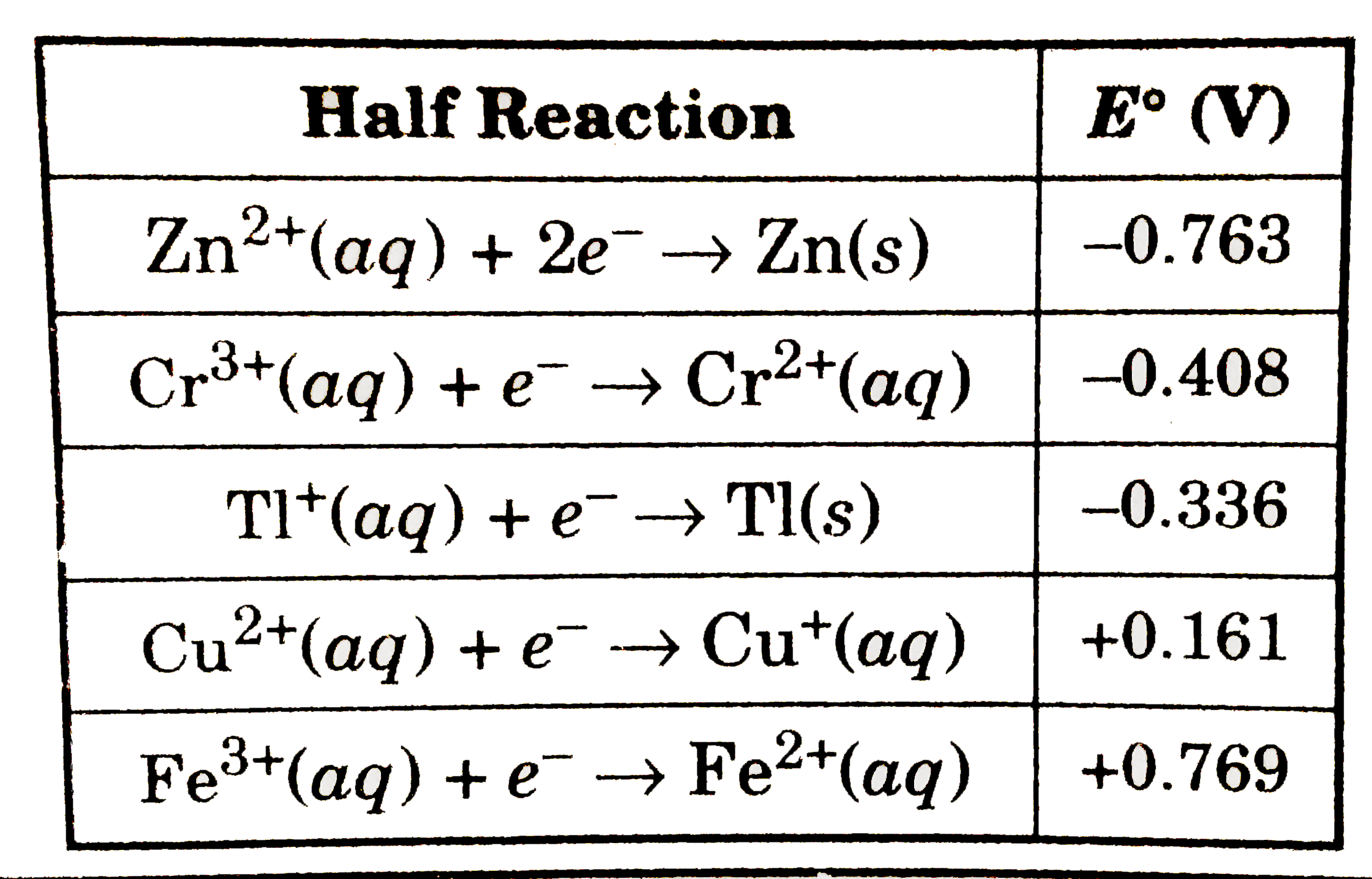For the reaction shown , which which is closest to the value o fΔH?
ΔH∘f(KJ.mol−1)Cr3+(aq)−143Ni2+(aq)−54
2Cr3+(aq)+3Ni(s)→2Cr(s)+3Ni2+(aq)
124KJ
89KJ
−89Kj
−124KJ
The correct Answer is:a
Step by step video, text & image solution for For the reaction shown , which which is closest to the value o fDeltaH? {:(DeltaH_(f)^(@),(KJ.mol^(-1))),(Cr^(3+)(aq),-143),(Ni^(2+) (aq),-54):} 2Cr^(3+)(aq)+3Ni(s)to2Cr(s)+3Ni^(2+)(aq) by Chemistry experts to help you in doubts & scoring excellent marks in Class 11 exams.
Updated on:21/07/2023Topper's Solved these Questions
Similar Questions
Find total number of metal cations which are ppted as metal sulphide on passing H2S gas through metal salt solution.
Pb2+(aq.), Mn2+(aq.), Sn2+(aq.), Cr3+(aq.), Mg2+(aq.), Hg2+(aq.), Cu2+(aq.), Ag+(aq.), Al3+(aq.), Ni2+(aq.)
View Solutionwhat is the standard electrode potential for the reduction of HClO?
HClO(aq)+H+(aq+2e−→Cl−(aq)+H2O(l)
Given: Cr2(aq)→Cr3+(aq)+e−,E∘=0.41V
HClO(aq)+H+(aq)+2Cr2+(aq)→2Cr3+(aq)+H2O(l),E∘=1.80
View Solution
Knowledge Check
Which expression gives the value for ΔG∘ in kJ mol−1 for this reaction at 25∘C?
2Cr(s)+3Cu2+(aq)→2Cr3+(aq)+3Cu(s) E∘=0.43VA−6×8.31×0.43×1000B−6×96500×0.43×10008.31C−6×96500×0.431000D−6×8.31×0.431000Cr2O2−7+H++SO2−3→Cr3+(aq.)+SO2−4
AFor disproportionation reaction.BFor comproportionation reaction.CFor either intermolecular redox reaction or displacement reactionDFor either thermal combination redox reaction or thermal decomposition redox reaction.At 298 K, the standard reduction potentials for the following half reactions are given. Which acts as anode with others in electrochemical cell
Zn+2(aq)+2e−→Zn(s),−0.762
Cr+3(aq)+3e−→Cr(s),−0.740
2H+(aq)+2e−→H2(g),−0.000
Fe+3(aq)+e−→Fe2+(aq),+0.762AZn(s)BH2(g)CCr(s)DFe2+ (aq)

Based on the standard reduction potentials above, which reaction(s) is (are) spontaneous?
(P) Cr2+(aq)+Fe3+(aq)→Cr2+(aq)+Fe2+(aq)
(Q) Cu2+(aq)+Fe2+(aq)→Cu2+(aq)+Fe3+(aq)
View SolutionFe2+(aq.)+Cr2O2−7+H+→Fe3+(aq.)+Cr3+
View SolutionFe2+(aq.)+Cr2O2−7+H+→Fe3+(aq.)+Cr3+
View SolutionWhat is the coefficients of I2 (s) when the reaction below is balanced with smallest whole number coefficients?
____Cr2O2−7(aq)+____.−(aq)+____H+(aq)→_____I2(s)+___Cr3+(aq)+___H2O(l)
View SolutionNickel metal is added to a solution containign 1.0 m Pb2+(aq) and 1.0MCd^(2+)(aq).Usethestandardreductionpotentials→determinewhichreaction(s)willour.<br>Reaction1:Ni(s) + Pb^(2+)(aq) rightarrow Pb(s) + Ni^(2+)(aq)<br>Reaction2:Ni(s) + Cd^(2+)(aq) rightarrow Cd(s) + Ni^(2+)(aq)<br>{:("Reaction", E^(@)), (Pb^(2+)(aq) + e^(-) rightarrow Pb(s) , -0.13V), (Ni^(2+)(aq) + 2e^(-) rightarrow Ni(s), -0.23V), (Cd^(2+)(aq) + 2e^(-) rightarrow Cd(s), -0.40V):}
View Solution
